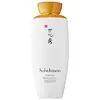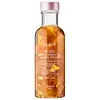What's inside
What's inside
 Key Ingredients
Key Ingredients

 Benefits
Benefits

 Concerns
Concerns

 Ingredients Side-by-side
Ingredients Side-by-side

Water
Skin ConditioningAlcohol
AntimicrobialBetaine
HumectantButylene Glycol
HumectantGlyceryl Polymethacrylate
Glycerin
HumectantPEG/PPG-17/6 Copolymer
SolventGlycereth-26
HumectantPhenoxyethanol
PreservativePEG-60 Hydrogenated Castor Oil
EmulsifyingBis-PEG-18 Methyl Ether Dimethyl Silane
EmollientHoney
HumectantAcrylates/C10-30 Alkyl Acrylate Crosspolymer
Emulsion StabilisingNelumbo Nucifera Flower Extract
Skin ConditioningPolygonatum Officinale Rhizome/Root Extract
Skin ConditioningRehmannia Glutinosa Root Extract
Skin ConditioningPaeonia Albiflora Root Extract
Skin ConditioningLilium Candidum Bulb Extract
Skin ConditioningEthylhexylglycerin
Skin ConditioningDiphenylsiloxy Phenyl Trimethicone
Skin ConditioningParfum
MaskingPortulaca Oleracea Extract
Skin ConditioningCamellia Sinensis Leaf Extract
AntimicrobialPotassium Hydroxide
BufferingDisodium EDTA
Limonene
PerfumingBiosaccharide Gum-1
HumectantGlycyrrhiza Uralensis Root Prenylflavonoids
Skin ConditioningNatto Gum
Sodium Hyaluronate
HumectantLinalool
PerfumingPropanediol
SolventBHT
AntioxidantAcetic Acid
BufferingTocopherol
AntioxidantBeta-Glucan
Skin ConditioningWater, Alcohol, Betaine, Butylene Glycol, Glyceryl Polymethacrylate, Glycerin, PEG/PPG-17/6 Copolymer, Glycereth-26, Phenoxyethanol, PEG-60 Hydrogenated Castor Oil, Bis-PEG-18 Methyl Ether Dimethyl Silane, Honey, Acrylates/C10-30 Alkyl Acrylate Crosspolymer, Nelumbo Nucifera Flower Extract, Polygonatum Officinale Rhizome/Root Extract, Rehmannia Glutinosa Root Extract, Paeonia Albiflora Root Extract, Lilium Candidum Bulb Extract, Ethylhexylglycerin, Diphenylsiloxy Phenyl Trimethicone, Parfum, Portulaca Oleracea Extract, Camellia Sinensis Leaf Extract, Potassium Hydroxide, Disodium EDTA, Limonene, Biosaccharide Gum-1, Glycyrrhiza Uralensis Root Prenylflavonoids, Natto Gum, Sodium Hyaluronate, Linalool, Propanediol, BHT, Acetic Acid, Tocopherol, Beta-Glucan
Water
Skin ConditioningGlycerin
HumectantPropanediol
Solvent1,2-Hexanediol
Skin ConditioningPolyglycerin-3
HumectantRosa Centifolia Flower
MaskingRosa Damascena Flower Water
MaskingRosa Damascena Extract
MaskingRosa Multiflora Fruit Extract
MaskingRosa Damascena Flower Extract
MaskingAngelica Keiskei Extract
AntioxidantRosa Damascena Flower Oil
MaskingButylene Glycol
HumectantSodium Citrate
BufferingCitric Acid
BufferingXanthan Gum
EmulsifyingSodium Hyaluronate
HumectantCaprylyl Glycol
EmollientChlorphenesin
AntimicrobialSodium Benzoate
MaskingPotassium Sorbate
PreservativeCitronellol
PerfumingGeraniol
PerfumingWater, Glycerin, Propanediol, 1,2-Hexanediol, Polyglycerin-3, Rosa Centifolia Flower, Rosa Damascena Flower Water, Rosa Damascena Extract, Rosa Multiflora Fruit Extract, Rosa Damascena Flower Extract, Angelica Keiskei Extract, Rosa Damascena Flower Oil, Butylene Glycol, Sodium Citrate, Citric Acid, Xanthan Gum, Sodium Hyaluronate, Caprylyl Glycol, Chlorphenesin, Sodium Benzoate, Potassium Sorbate, Citronellol, Geraniol
 Reviews
Reviews

Ingredients Explained
These ingredients are found in both products.
Ingredients higher up in an ingredient list are typically present in a larger amount.
Butylene Glycol (or BG) is used within cosmetic products for a few different reasons:
Overall, Butylene Glycol is a safe and well-rounded ingredient that works well with other ingredients.
Though this ingredient works well with most skin types, some people with sensitive skin may experience a reaction such as allergic rashes, closed comedones, or itchiness.
Learn more about Butylene GlycolGlycerin is already naturally found in your skin. It helps moisturize and protect your skin.
A study from 2016 found glycerin to be more effective as a humectant than AHAs and hyaluronic acid.
As a humectant, it helps the skin stay hydrated by pulling moisture to your skin. The low molecular weight of glycerin allows it to pull moisture into the deeper layers of your skin.
Hydrated skin improves your skin barrier; Your skin barrier helps protect against irritants and bacteria.
Glycerin has also been found to have antimicrobial and antiviral properties. Due to these properties, glycerin is often used in wound and burn treatments.
In cosmetics, glycerin is usually derived from plants such as soybean or palm. However, it can also be sourced from animals, such as tallow or animal fat.
This ingredient is organic, colorless, odorless, and non-toxic.
Glycerin is the name for this ingredient in American English. British English uses Glycerol/Glycerine.
Learn more about GlycerinPropanediol is an all-star ingredient. It softens, hydrates, and smooths the skin.
It’s often used to:
Propanediol is not likely to cause sensitivity and considered safe to use. It is derived from corn or petroleum with a clear color and no scent.
Learn more about PropanediolSodium Hyaluronate is hyaluronic acid's salt form. It is commonly derived from the sodium salt of hyaluronic acid.
Like hyaluronic acid, it is great at holding water and acts as a humectant. This makes it a great skin hydrating ingredient.
Sodium Hyaluronate is naturally occurring in our bodies and is mostly found in eye fluid and joints.
These are some other common types of Hyaluronic Acid:
Learn more about Sodium HyaluronateWater. It's the most common cosmetic ingredient of all. You'll usually see it at the top of ingredient lists, meaning that it makes up the largest part of the product.
So why is it so popular? Water most often acts as a solvent - this means that it helps dissolve other ingredients into the formulation.
You'll also recognize water as that liquid we all need to stay alive. If you see this, drink a glass of water. Stay hydrated!
Learn more about Water